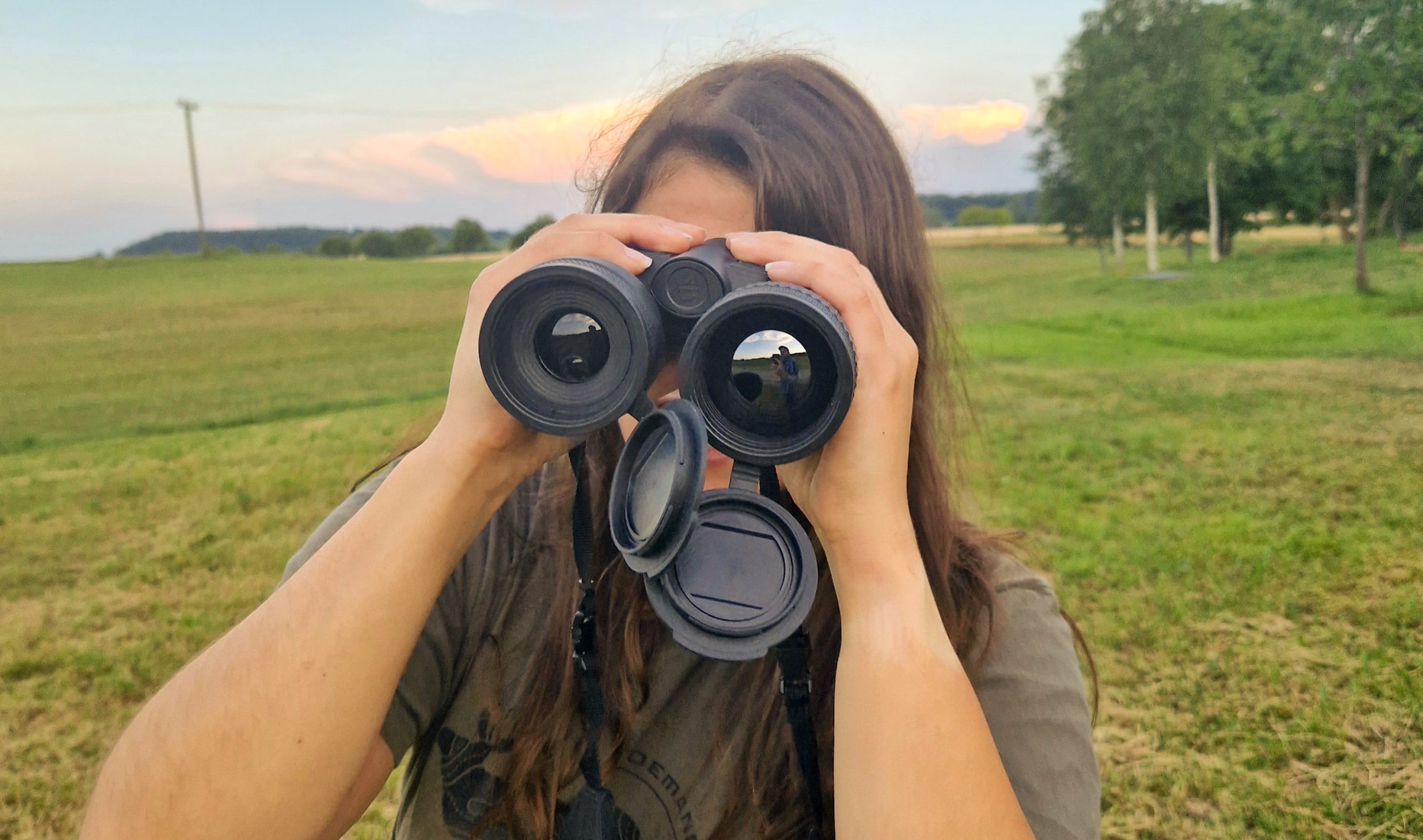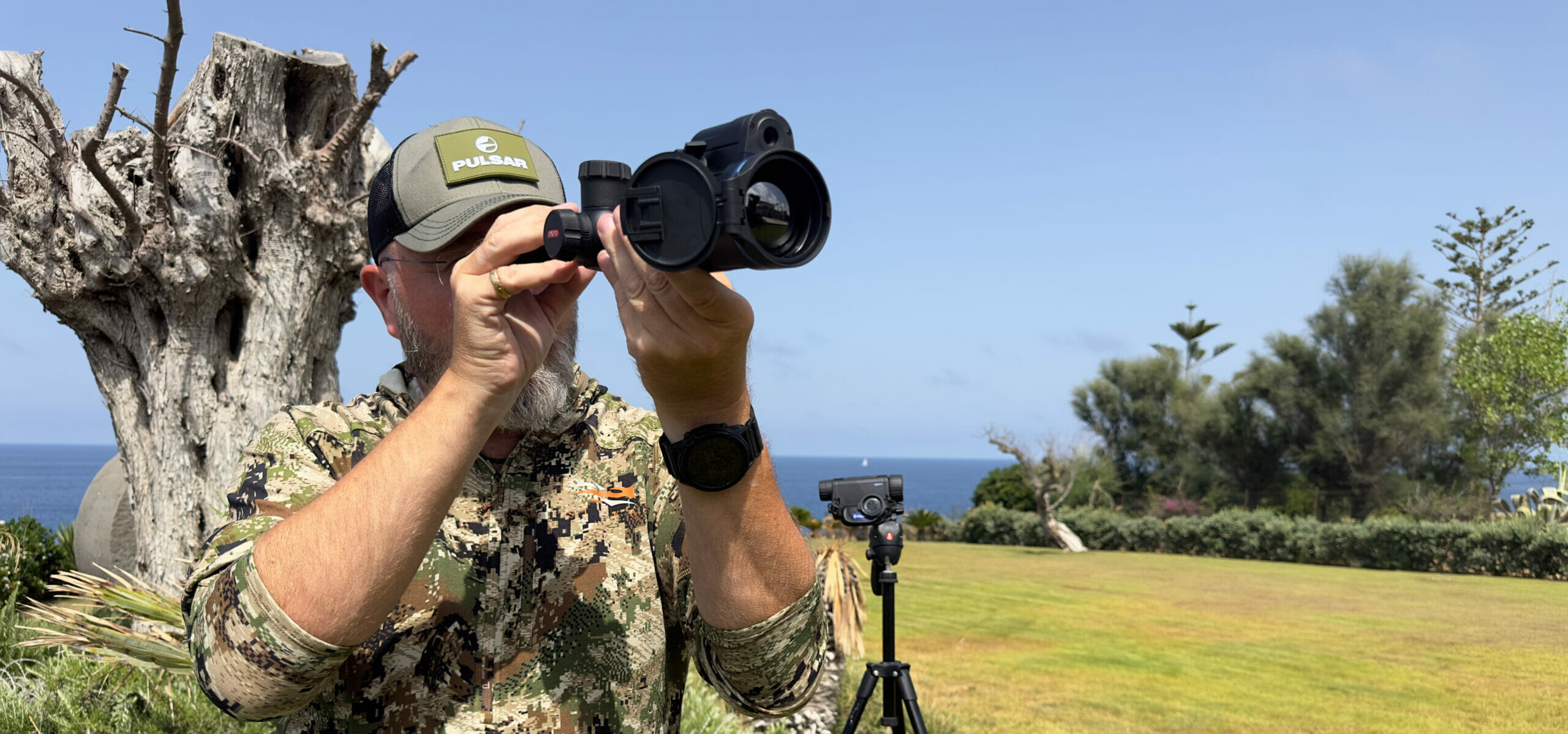While Pulsar only makes equipment for civil use and law enforcement, we can’t help but notice certain similarities hunting and military have in common: progression on the ground, gun safety, and shooting skills are just a few of them. To explore them, we asked hunters with military backgrounds to help. Here is what Jorge Costa from Portugal, Claudia Breit from Germany, and Danish Claus S. Anderson, who currently resides in Sicily, told us.
Serving for the better
We begin the conversation by sharing stories of joining the military. For both men, it was, at least at first, a childhood dream, a profession that seemed incredibly cool and exciting. “As a child, I always had a dream of being in the military one day. Everything involving weapons, shooting, going through large extensions in the middle of the jungle, the physical part, and trying to overcome all these challenges seemed exciting. When I saw something about the Marines on TV, my curiosity was aroused. The Marines are an elite unit of the Portuguese Navy, and it is a great pride to belong to that force,” says Jorge Costa.
Claus. S. Anderson’s dream was sparked by a generational interest: “As far as I can remember, I’ve always wanted to be a soldier in the Danish Defense Forces because of my father and uncle’s engagement in the military. When I was younger, it was mostly because of the “adventurous” and glamorous side. Later on, as I gained more experience, my motivation changed more towards being able to make a difference, although small sometimes, and to be able to help civilians who were in a bad spot. The experiences I gained by doing my job on numerous deployments all over the world also gave me a lot of insight into myself and my behavior, as well as human psychology in general.”
And yet, for Claudia Breit, it wasn’t always this straightforward. “Funny enough, I never wanted to join the military when I was in school because I was very overweight at the time and was afraid of basic training. But with my parents moving out and a change in lifestyle, I was looking for a job with a higher purpose. Accordingly, I looked around, and a career in the military fit my attitude and lifestyle. Relatively quickly, I signed the contract and took off,” admits the German huntress.
Into the woods
While we could see some parallels in our hunters’ wish to join the military, their paths to hunting are quite different. To Jorge, similarly like with hunting, it was always a childhood passion. When we first visited him in Portugal a little while ago, he’d admitted having started hunting at the age of 11 – little birds with a slingshot first, then onto some still targets, later – with a crossbow, until he finally came of age to get his license. His father has played a role in this, too – although not a hunter initially, he’d spend hours in the forest with his son, thus instilling a love for nature.
In Claudia’s case, it, too, was the love for animals. While transitioning from loving animals to hunting them hasn’t been particularly smooth for her, she soon came to realize that hunting goes way beyond the shot and that it is, in fact, a way to care for nature.
To Claus, however, hunting came later in life. While receiving his S.E.R.E. (Survival, Evasion, Resistance, and Escape) training, he was introduced to primitive hunting. But, being a perfectionist, he wasn’t particularly happy about the results. “After that course, I decided to become a “real” hunter, and I talked to my wife, Freya, about it. She was all for it and even decided to become a huntress as well. We both wanted to take a course that could prepare us as best as possible, so we chose the one that took almost 6 months to complete. Finally, we became certified Danish hunters at the end of 2016, and from then on, our hunting adventures have exploded. For us, hunting is not a hobby. It’s our passion and lifestyle to be able to live directly off what nature can provide for us. We have been hunting in Denmark, Sweden, Ireland and South Africa. Currently, we are applying for an Italian permit so we can hunt in Sicily and all over Italy,” explains Claus.
The best of both worlds
Transferable skills are arguably some of the most valuable ones a person can acquire, and in the case of military and hunting, there are many overlapping areas. “From your progression on the ground behind your target to the weaponry safety and shooting skills, these are the qualifications required in both fields,” says Jorge.
He goes on to explain that both military and hunting experience helps him to stay calmer, be more efficient and precise when it comes to making the shot – or to decide when the conditions are not right for it.
Perhaps unsurprisingly, Claus makes similar points – and elaborates on them slightly further: “The shooting skills and knowledge of weapon handling during day and night were very beneficial for me. But I could also employ my knowledge about the effect of a rifle round being fired into the safety aspect of hunting. Knowing what to look for in the background and making sure the bullet would be caught by the ground or an earth berm was also essential. Even my man-tracking skills could be used when I was stalking an animal. I would also like to think that my life experiences as a professional soldier have helped me in taking the right decisions when choosing to take the life of an animal.”
Claudia weighs in to mention the importance of physical preparation: “I think what should not be underestimated is the physical load capacity. Those who are fitter also hunt better. Also, sometimes it helps to be patient and just be able to sit still for a long time.”
The differences in the gear
You could easily think that, coming from a military background, hunters would be very picky about their gear. But Claudia surprises us: “On the contrary. I am used to working and shooting with absolutely standard equipment. Hunting is often a luxury. But I like the fact that I can get along with anything.”
Jorge agrees that having worked in the military really makes you appreciate what the civilian market has to offer, noting that “at this moment, we are very, very advanced” in terms of equipment. To elaborate on the differences, we turn to Claus, who distinguishes two categories of military gear: “Pulsar will often have a more complex and multi-usage product, while the military-grade device often will lack the full spectrum of features and modes. Not to say the military-grade device is of lesser quality, but it is often more tailored to a specific line of tasks and therefore doesn’t need a multitude of features and modes. However, some military-grade pieces of equipment might be developed to facilitate a wide range of tasks, and therefore might be as diverse as five different civilian-grade types of gear.”
A self–proclaimed gear freak, the Danish hunter admits to loving testing multiple pieces of equipment and therefore has lots of it. Luckily for Claus, his wife shares the same passion, not objecting to his hoarding. Naturally, I’m curious what someone with such extensive knowledge would choose from Pulsar – especially provided that our gear is made for civilian and law enforcement use only and is far from qualifying as military-grade.
“I’m leaning towards three types of devices. The first choice is the Axion 2 small handheld spotter. It can be used for a quick trip in nature to discover a lot of different types of wild game either on your hunting grounds or just while you are enjoying a long walk. Axion 2 is small, handy and able to deliver quality images while, at the same time, having a long battery life.
My second choice would be the Merger LRF series. I would use this for either a hunting scenario or a hike where I have the possibility to carry a heavier device. I really appreciate the longer detection range combined with a laser range finder that can measure distances covering all relevant hunting distances for me. The bigger sensor will also give me a more detailed image, so I’m better able to identify what I’m looking at, day or night.
The third choice would, without any doubt, be a riflescope or a clip-on like the Krypton or Proton series. I like the idea of a clip-on, especially if it can be used as a handheld device, too. This way, I can use my optical rifle scope in areas where digital aids are not permitted, and I can also use the clip-on as a handheld spotter if needed.
Using a dedicated electronic riflescope like the Talion or Thermion series would be a luxury I can only dream of, especially one equipped with a laser range finder. The ability to exploit all the features and modes in such a device would be amazing for me, and I’m sure I would spend many hours behind the scope, hunting or just at home, trying to exploit all its features,” shares the hunter.
The informed choosers
It’s interesting to see how people with such an amount of experience pick their gear. For Claudia, high functionality comes first: “I don’t think much of overpriced and supposedly good-looking. It should always be able to achieve the highest possible hunting accuracy to suit the hunter.”
Claus, as you could guess from his earlier insights, looks for quality as much as he looks for the ability of multipurpose use. “I really like gear where I can combine it with another type of gear, so it will support me in my hunt even better. For example, the ability to combine a riflescope or binoculars or a spotter with a smartphone or smartwatch, so I can quickly get an overview of the hunting grounds, or it can provide me with a usable ballistic solution for a long shot. When I discover these features, I always try to see if the combination can help me in other ways than perhaps intended by the manufacturer. I can spend endless hours trying to make things work so they can support the “out-of-the-box” ideas I might have.”
And for Jorge, image quality and definition are of the highest priority. Then he looks at the weight of the device (the lighter, the better), the simplicity of the menu, battery life, and, finally, aesthetics. Knowing the criteria, it’s no surprise that Jorge is a great fan of the Thermion line. Meanwhile, Claudia and Claus, the newest members of the Pulsar family, are still in the process of picking out the ultimate favorites – and we can’t wait to hear about them soon.
Please note that Pulsar equipment is made solely for civilian and law enforcement use, primarily – hunting. It does not and never has qualified as military-grade equipment, nor do we aim to present it as such.
Before purchasing any night or thermal vision device, please make sure you adhere to the local legislation and only use it when it is allowed. Our ambassadors come from various countries and travel a lot, which allows them to test different devices. We do not encourage or support the illegal use of our devices in any events. If you wish to learn more about export and sales restriction policy, please visit the following link: Export and Sales Restriction Policy.



